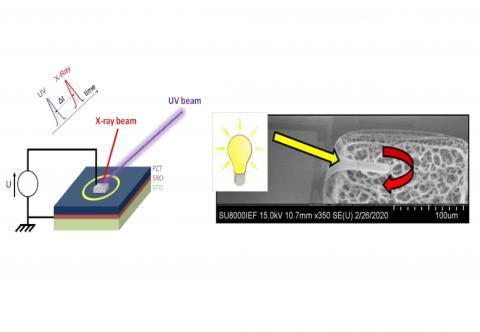
Photo-induced effects in ferroelectric thin film based devices
Photo-induced effects in ferroelectric thin film based devices
Ferroelectric materials exhibit coupled degrees of freedom and possess a switchable electric polarization coupled to strain, making them good piezoelectrics and enabling numerous devices including non-volatile memories, actuators and sensors. Moreover, novel photovoltaic effects are encountered through the interplay of electric polarization with the materials optical properties. Consequently, the light-induced deformation in ferroelectrics, or photostriction, combining photovoltaic and converse piezoelectric effects, is under investigation in the quest for multifunctional materials.
Recent studies in ferroelectric thin films have reported photo-induced strain in the picosecond time range, thus opening a new route for ultrafast strain engineering and optical actuation in devices. However, the polarization is usually in as-grown state, so its contribution on the photostrictive response is not well understood.
In this presentation, we demonstrate that tuning the ferroelectric polarization allows controlling photo-induced current and ultrafast photo-induced strain in PZT thin films based capacitors. Recent promising results are also showing that light can be used to control the mechanical response of PZT MEMS. These measurements provide fundamental insight into light-matter interaction in ferroelectrics and exciting new avenues for materials functionality engineering.
Fig.: (Left) PZT ferroelectric capacitors measured by time-resolved X-ray diffraction, showing an in situ control of the fast photo-induced expansion or contraction following a UV pulse. (Right) PZT-based MEMS whose mechanical response can be tuned by light.
Dr. Sylvia Matzen received her Engineering degree in 2008 from ESPCI (Paris) and her PhD degree in physics in 2011 from the University Paris-VI (CEA PhD grant). After a post-doctoral position at the University of Groningen (Netherlands), she joined the Institute of Fundamental Electronics (IEF, today C2N) as assistant professor in 2013. Her research activities are centered on the epitaxial growth of oxide thin films and on the tuning of their properties (especially ferroelectric and piezoelectric) by strain engineering. Since 2015, her research work focuses on photo-induced effects in ferroelectric thin films and devices, using a wide range of characterisation techniques, especially with synchrotron radiation.
Lien public: https://zoom.us/j/95148164142
chez soiPhoto-induced effects in ferroelectric thin film based devices
Ferroelectric materials exhibit coupled degrees of freedom and possess a switchable electric polarization coupled to strain, making them good piezoelectrics and enabling numerous devices including non-volatile memories, actuators and sensors. Moreover, novel photovoltaic effects are encountered through the interplay of electric polarization with the materials optical properties. Consequently, the light-induced deformation in ferroelectrics, or photostriction, combining photovoltaic and converse piezoelectric effects, is under investigation in the quest for multifunctional materials.
Recent studies in ferroelectric thin films have reported photo-induced strain in the picosecond time range, thus opening a new route for ultrafast strain engineering and optical actuation in devices. However, the polarization is usually in as-grown state, so its contribution on the photostrictive response is not well understood.
In this presentation, we demonstrate that tuning the ferroelectric polarization allows controlling photo-induced current and ultrafast photo-induced strain in PZT thin films based capacitors. Recent promising results are also showing that light can be used to control the mechanical response of PZT MEMS. These measurements provide fundamental insight into light-matter interaction in ferroelectrics and exciting new avenues for materials functionality engineering.
Fig.: (Left) PZT ferroelectric capacitors measured by time-resolved X-ray diffraction, showing an in situ control of the fast photo-induced expansion or contraction following a UV pulse. (Right) PZT-based MEMS whose mechanical response can be tuned by light.
Dr. Sylvia Matzen received her Engineering degree in 2008 from ESPCI (Paris) and her PhD degree in physics in 2011 from the University Paris-VI (CEA PhD grant). After a post-doctoral position at the University of Groningen (Netherlands), she joined the Institute of Fundamental Electronics (IEF, today C2N) as assistant professor in 2013. Her research activities are centered on the epitaxial growth of oxide thin films and on the tuning of their properties (especially ferroelectric and piezoelectric) by strain engineering. Since 2015, her research work focuses on photo-induced effects in ferroelectric thin films and devices, using a wide range of characterisation techniques, especially with synchrotron radiation.
Lien public: https://zoom.us/j/95148164142
